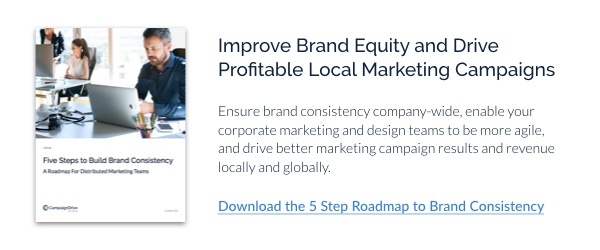Brand consistency means delivering customer experiences that authentically represent your brand's essence on a reliable, consistent basis.
That's definitely a complex definition, so let's give an example. If you go to Chipotle, you know what to expect. You'll encounter steel walls with Aztec motifs in bronze and wood. You'll walk out with a recycled brown paper bag. Your napkins will also be post-consumer paper, and the menu will offer the same delicious food as the Chipotle you visited last week.
In other words, brand consistency is about consistently delivering on your brand's promise in subtle ways – ways your customers may not realize, but definitely feel.
Creating this familiar and repeatable experience is key to multi-location growth. While there are numerous positives that stem from creating strong and consistent branding, three key benefits of brand consistency include:
-
Gaining Positive, Instant Brand Associations in the Customer's Mind
-
Being Perceived as Dependable
-
Improved Customer Trust
Why is Brand Consistency Important?
Brand consistency "implants" your brand in the mind of a new customer. When they come back and notice the same advertising, packaging, décor and menu items, it creates a repeated, positive impression. It works to reinforce happy associations with your products. Because of this consistency, your customers begin to perceive you as trustworthy and develop brand loyalty.
What happens if you're not nailing brand consistency in your local marketing?
You're at risk of losing customer trust.
We're not just talking about bad Yelp reviews from a dissatisfied local customer. It's a lot more subtle – a subconscious erosion of your brand's value.
A national advertising campaign that "looks" and "feels" different than the in-store experience damages brand trust. Subtle signals that create a disjointed experience will create cognitive dissonance for your customers. They'll start to associate this unpleasant experience with your brand.
Loss of trust subtly erodes a sense of the brand’s perceived value and reliability, which happens gradually and can be nearly impossible to measure. Brand trust can erode because of “shoddy” advertising that feels cheap and creates a bad impression with customers on a local (face-to-face) level.
Maintaining brand consistency is one of the hardest parts of the job for brand managers, who often manage hundreds of local outlets. How can you enable local teams, keep them on brand, and support their local marketing efforts? Read on to find out.
How to Achieve Brand Consistent Delivery in 4 Steps
1. Understand the Two Types of Consistency
Even for brands with few local outlets, consistency is difficult to achieve and sustain. Brand managers need to balance two types of consistency in their marketing: rote consistency and semantic consistency. Here's the difference:
- Rote Consistency: the same thing over and over again.
- Semantic Consistency: the same idea expressed repeatedly, in different ways.
Rote consistency has a distinct place, and works as a consistent beat promoting a key differentiator of the brand to the world. You've seen tons of insurance commercials, but everyone knows that you can "save 15% or more on car insurance by switching to GEICO." Even people who have a different insurance provider will repeat that phrase to their friends in weird situations. That's rote consistency!
However, semantic consistency is often what creates freshness for the customer while still enforcing brand consistency. It's the familiar message, with a twist. Potential customers will know the message and are more likely to appreciate and remember it when it's given an unexpected or new delivery.
As a brand manager for a distributed brand, it's important to understand the difference between being flexible with consistency and going off-brand. Your job is to provide correction when your local marketers go off-brand, but foster the creative spirit driving your local marketers' attempts at flexible consistency.
2. Know When it's Okay for Locals to Innovate
Take caution when approaching flexibility around your brand's marketing assets - it is risky, but can often generate a positive response. In general, your local marketers can get creative and if they're innovating in the right ways. Consider if their efforts can be replicated elsewhere, and if you can transfer the idea to a national scale to create excitement around your brand. If so, it may be acceptable.
Local marketers have a different – closer to the ground – perspective, and can generate fresh ideas for expanding the brand's look, feel, and values in a way that resonates with customers. Doing something new isn't always a bad thing for local marketers – in very specific cases, it can actually be fantastic. In 2016, many brands won by doing something wildly different – examples include Snapchat's shocking release of Spectacles, and Qdoba's bold decision to let their fans determine the future of their queso flavor via Facebook.
User generated content is effective and powerful. Distributed brands should also consider leveraging partner-generated content. Content co-created with local partners, allows local marketers to truly be innovative and leverage their unique position on the front lines to create marketing messages that resonate with customers.
3. Provide Compliant Assets
In order to deliver consistent, relevant, local messaging, your local marketers need tools that make brand compliance easy. Specifically, they need assets that are easy to deploy in brand-compliant marketing materials.
Using a tool specifically designed to enable local marketing efforts with templates for digital, print, email, and other formats, brand managers make it easy for local teams to customize assets in all the right ways. Brand managers can set "rules" directly in the template to lock down the elements that cannot be edited (such as logo, typeface, or design), easily designate areas for content that can be modified, and suggest how things can/should be modified to guide local marketers toward creating the best ad possible.
4. Establish Tools for Both Rote and Semantic Consistency
Brand consistent delivery comes from well-managed asset templates that are built for easy compliance, and using the right tools and methods to execute marketing efforts. It's important to understand the tools and methods necessary to help your local marketers succeed at brand consistency. Including:
- Brand Guidelines: Your brand guidelines should be highly accessible to your local marketers. Keep this asset up-to-date, and use it to communicate the look, feel, and values of your brand.
- Brand Voice and Tone Book: Fill this resource with vibrant examples of creative local marketing execution that nailed your brand's voice and tone, as well as clear guidelines on what to do and not do.
- DAM System: Digital asset management (DAM) is a tool for organizing and distributing your assets. Systems designed for the needs of distributed organizations include metadata taxonomies, search, content tagging, and custom access permissions.
- LMA System: Local marketing automation (LMA) technology, which should optimally be combined with your DAM, may include local templating, reporting, content management, workflow, and integrations.
- Two-Way Communications: Regular check-ins with local affiliates can help you understand how accessible your brand's guidelines, tools, and assets are. By actively collecting feedback from your local marketers, you can also improve your understanding of customers and potential customers.
Brand Consistency at Scale with Marketing Technology
Managing the right expressions of brand consistency is never easy, but it's even harder for brand managers who are dealing with multiple local partners - distributed all over the nation or globe.
Technology can be key to enforcing consistency on the campaign and asset level. By adopting templates, digital asset management and local marketing automation, brand managers can support the right kinds of expressions of brand consistency at the local level.






